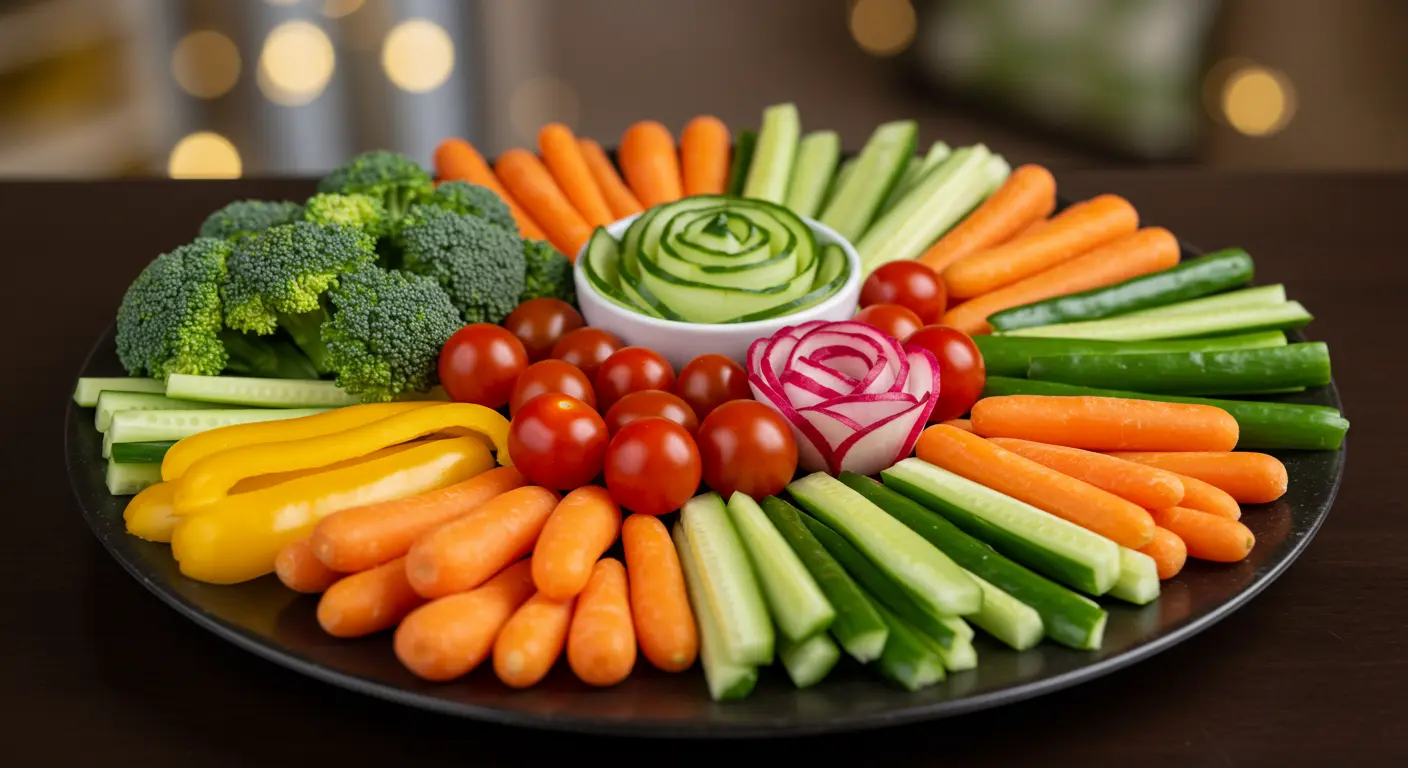Introduction
Are you tired of putting out the same boring vegetable platter at every gathering? We’ve all seen those sad veggie trays with limp carrots and dried-out broccoli sitting untouched at the end of the party. But what if your vegetable platter could be the star of the show—the appetizer guests actually flock to and photograph for social media?
As a culinary stylist and nutritionist with 12 years of experience creating food displays for everything from intimate dinner parties to corporate events, I’ve discovered that presentation transforms how people perceive and enjoy healthy foods.
In this comprehensive guide, I’ll share my eight most impressive vegetable platter designs that combine visual appeal with practical serving techniques. We’ll cover everything from choosing the right vegetables and arranging techniques to dip pairing suggestions and make-ahead tips to ensure your vegetable platter is not just nutritious but also the most talked-about dish at your next gathering.
Table of Contents
Why These Vegetable Platter Designs Work
Creating a stunning vegetable platter isn’t just about aesthetics—it’s about functionality and flavor too. These designs stand out because they:
- Use strategic color psychology to make healthy vegetables more appetizing
- Incorporate height and texture variations for visual interest
- Arrange vegetables for easy accessibility without awkward reaching
- Include strategic dip placement to minimize dripping and mess
- Feature vegetables at optimal temperatures and cutting styles for best flavor
Choosing the Right Vegetables
Seasonal Selections for Maximum Flavor
The foundation of an impressive vegetable platter begins with quality ingredients. Select vegetables at their peak season for the best flavor, color, and texture:
- Spring: Asparagus, radishes, snap peas, young carrots
- Summer: Bell peppers, cherry tomatoes, cucumber, zucchini
- Fall: Rainbow carrots, cauliflower varieties, Brussels sprouts
- Winter: Endive, watermelon radish, colorful root vegetables
Remember that a truly memorable vegetable platter incorporates unexpected elements. Consider adding edible flowers, unusual varieties like purple cauliflower, or heirloom vegetables for conversation starters.
Color Strategy for Visual Appeal
When planning your vegetable platter, think like an artist with food as your medium:
- Choose at least 5-7 different colors for maximum visual impact
- Balance bright colors (red peppers, orange carrots) with neutral tones (cauliflower, cucumber)
- Create contrast by pairing complementary colors (purple cabbage with yellow peppers)
Texture and Shape Considerations
Variety in textures makes your vegetable platter more interesting:
- Crunchy: Bell peppers, jicama, celery, carrots
- Soft: Cherry tomatoes, blanched asparagus tips
- Frilly: Endive leaves, frisée, kale
- Smooth: Cucumber, blanched green beans
Preparation Essentials
Vegetable Prep Techniques
Proper preparation ensures your vegetable platter looks and tastes its best:
- Wash all vegetables thoroughly and dry completely to prevent sogginess
- Cut vegetables no more than 4-6 hours before serving
- Blanch certain vegetables (like broccoli, green beans, or asparagus) for 30-60 seconds then ice-bath immediately for vibrant color and perfect texture
- Consider size and dippability—cut pieces that are easy to pick up and substantial enough to hold dip
Essential Tools
Having the right tools makes creating your vegetable platter much easier:
- Sharp knives for clean cuts
- Mandoline for consistent thin slices
- Cookie cutters for fun shapes
- Vegetable peeler for ribbons
- Small bowls for dips
- Tiered serving platters or boards with ample space
8 Beautiful Vegetable Platter Designs
1. The Color Wheel Arrangement
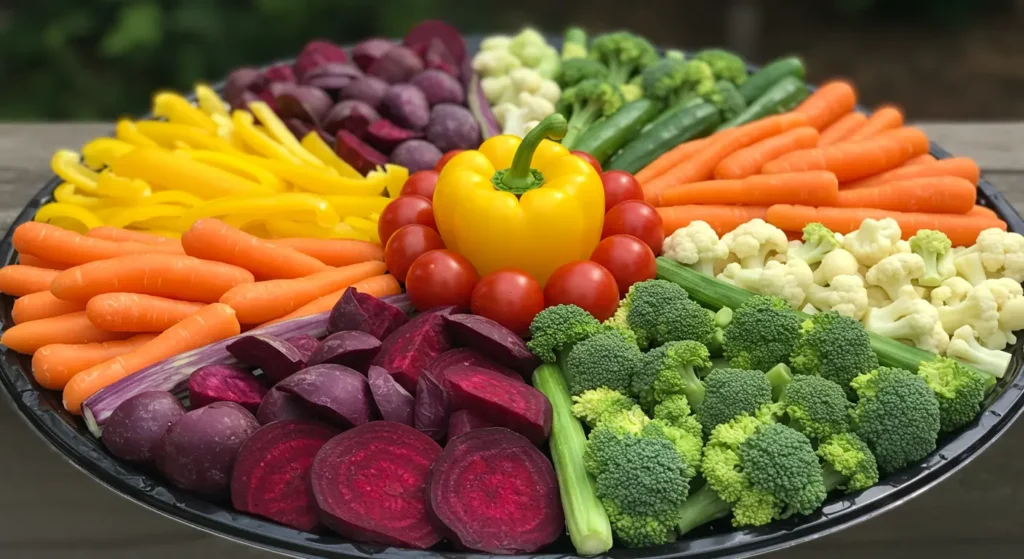
Create a stunning rainbow effect by arranging vegetables in color order around a central dip:
- Place a bowl of white dip (like ranch or tzatziki) in the center of a round platter
- Starting from the outer edge, arrange vegetables in rainbow order: radishes (red), carrots (orange), yellow peppers, cucumber (green), purple cabbage
- Create defined wedge sections for each color
- Add height by bunching taller vegetables like snap peas vertically in their section
This design works wonderfully for birthday parties, Pride celebrations, or any colorful gathering.
2. The Vertical Garden Display
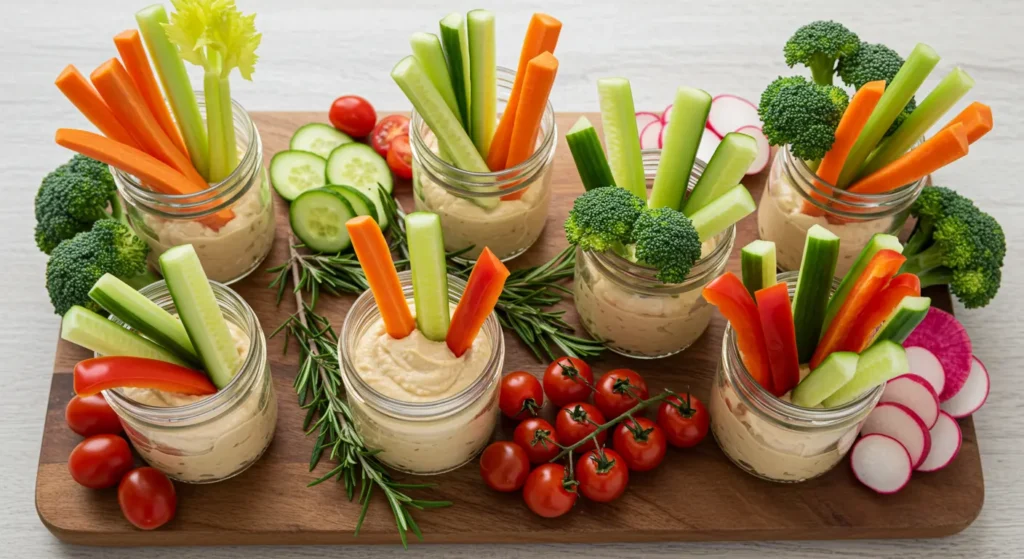
Transform your vegetable platter into a living garden that guests can harvest from:
- Fill several small glasses or mason jars 1/4 full with a thick dip (hummus works well)
- Stand vegetable sticks vertically in each jar like flowers in vases
- Arrange jars on a wooden board or tray with shorter vegetables arranged around them
- Add small herb sprigs between jars for a truly garden-like feel
This design keeps vegetables extra crisp and creates an impressive centerpiece effect.
3. The Geometric Pattern Platter
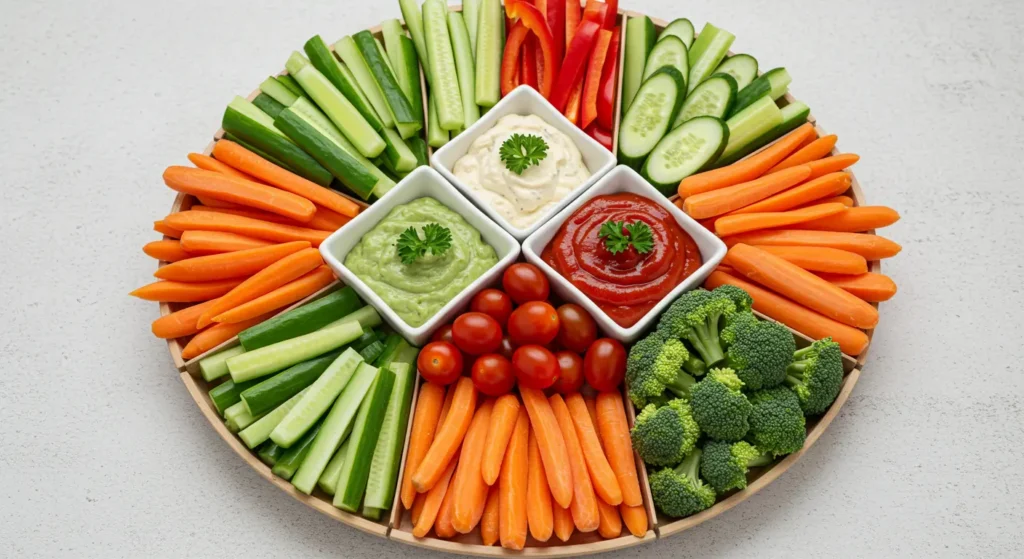
Create a modern, artistic vegetable platter with clean lines and repeating patterns:
- Divide your platter into a grid or concentric circles
- Fill each section with a different vegetable, creating a structured pattern
- Place dips in geometric containers that follow the same design theme
- Keep cuts consistent within each section (same size sticks, same thickness of rounds)
This architectural approach works beautifully for corporate events or modern dinner parties.
4. The Vegetable Platter Charcuterie
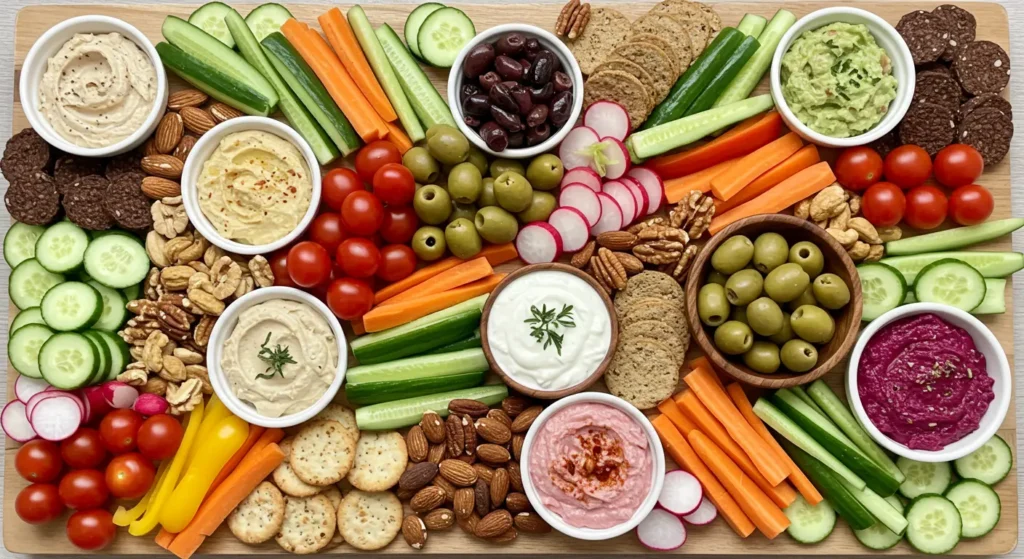
Borrow techniques from trendy charcuterie boards for a luxurious vegetable display:
- Use a large wooden board as your base
- Create meandering “rivers” of different vegetables across the board
- Intersperse small bowls of various dips
- Add complementary elements like olives, nuts, and crackers in clusters
- Fill every space for that abundant, overflowing effect
This style creates a grazing board that encourages mingling and conversation.
5. The Seasonal Basket Display
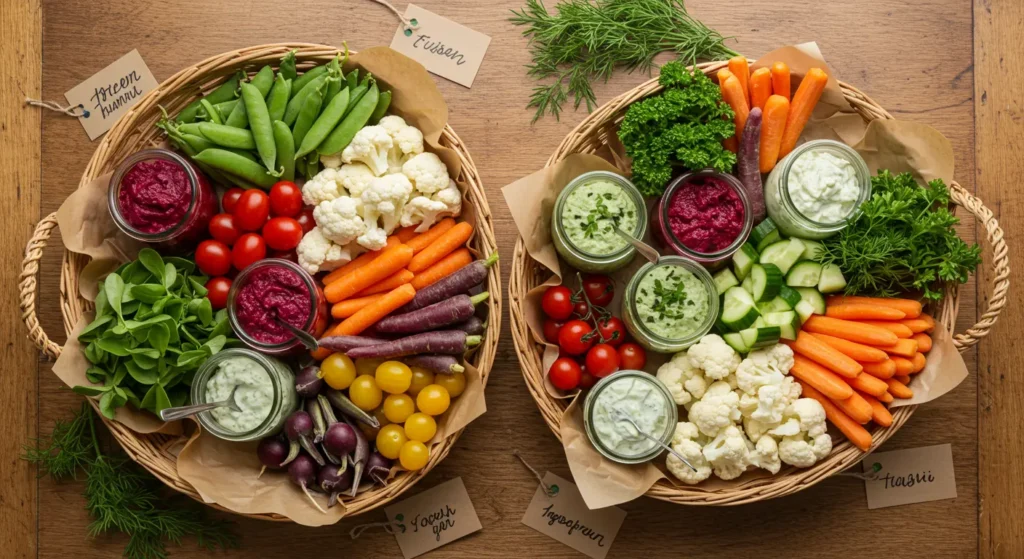
Create a farmers market feel with this rustic vegetable platter presentation:
- Line several small baskets with parchment paper
- Fill each basket with a different vegetable variety
- Place small jars of dip between baskets
- Add handwritten labels on small cards for an artisanal touch
- Garnish with fresh herbs scattered throughout
This arrangement works beautifully for farm-to-table gatherings or outdoor events.
6. The Sculptural Centerpiece
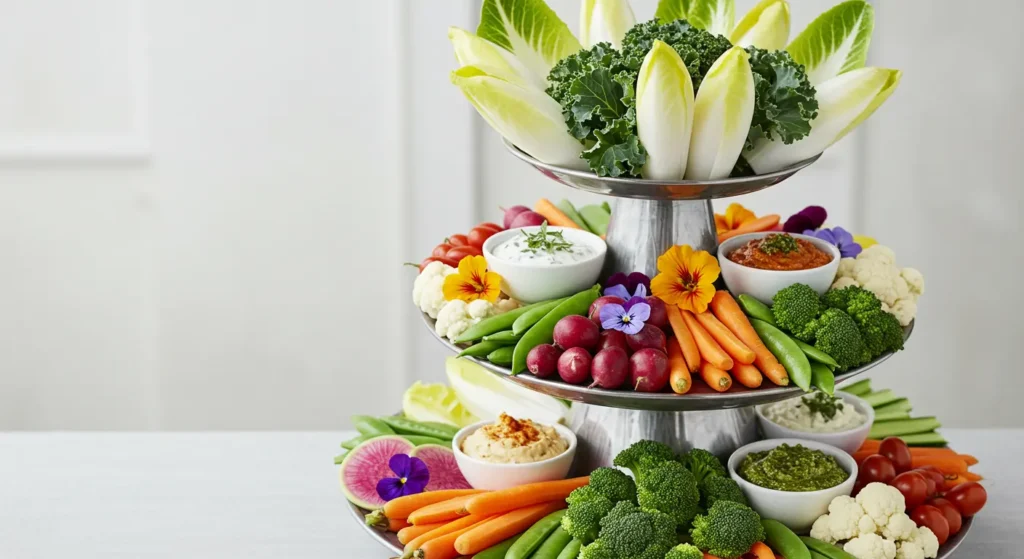
Transform your vegetable platter into a conversation-starting edible sculpture:
- Use a tiered stand as your base structure
- Create a vertical focal point with endive leaves or kale arranged like a blooming flower
- Cascade vegetables down the levels, from lightest at top to heaviest at bottom
- Position dips strategically on each tier
- Add edible flowers as finishing touches
This showstopping vegetable platter works wonderfully for special occasions and holiday gatherings.
7. The Dippable Vegetable “Bouquets”

Individual vegetable arrangements make for easy serving at larger gatherings:
- Place a small portion of dip at the bottom of short drinking glasses
- Arrange various vegetable sticks vertically in each glass like a bouquet
- Place glasses on a serving tray for guests to take individually
- Include different vegetable combinations in different glasses
This design is perfect for cocktail parties where guests are standing and mingling.
8. The Seasonal Mandala Design

Create a beautiful circular pattern that guests will hesitate to disturb:
- Place a round bowl of dip in the center of a circular platter
- Arrange vegetables in concentric circles around the dip, creating a mandala pattern
- Alternate colors, textures, and shapes as you move outward
- Add small touches like cherry tomatoes or olives as “dots” throughout the design
This artistic approach creates a meditative, beautiful vegetable platter that looks professionally designed.
Pro Tips for Perfect Vegetable Platters
Avoiding Common Mistakes
- Prevent browning: Dip cut apples, avocados, or artichokes in lemon water
- Avoid sogginess: Thoroughly dry vegetables after washing and store with paper towels
- Maintain crispness: Soak cut vegetables like carrots and celery in ice water for 30 minutes before arranging
- Prep smart: Prepare sturdy vegetables ahead, but wait until just before serving for delicate items
Tool Recommendations
- Wooden boards provide warm, natural backdrops for colorful vegetables
- Marble platters offer elegant contrast and keep vegetables cool
- Slate boards with chalk labels create an artisanal feel
- Tiered stands add height and drama to your vegetable platter
Storage & Make-Ahead Tips
- Prep vegetables up to 24 hours ahead, but store them separately wrapped in damp paper towels
- Assemble your vegetable platter no more than 2 hours before serving
- Cover with slightly damp paper towels, then plastic wrap if needed
- Keep refrigerated until 20 minutes before serving
Dip Pairings That Elevate Your Vegetable Platter
The right dips transform a good vegetable platter into an unforgettable one:
Classic Dips with Twists
- Hummus with roasted red pepper or herbs swirled on top
- Ranch dressing infused with fresh dill and lemon zest
- Greek yogurt tzatziki with cucumber and mint
- Baba ganoush topped with pomegranate seeds
Creative Dip Presentation
- Use hollowed vegetables (bell peppers, small cabbage heads) as natural dip bowls
- Create color gradients with different dips side by side
- Offer warm dips (like spinach artichoke) in small warming vessels
- Provide both creamy and chunky options for texture variety
Themed Vegetable Platter Ideas
Seasonal Inspirations
- Spring: Asparagus, watermelon radish, snap peas with herb-green goddess dip
- Summer: Heirloom tomatoes, cucumber, multicolored peppers with whipped feta
- Fall: Rainbow carrots, cauliflower, Brussels sprout halves with pumpkin hummus
- Winter: Endive, watermelon radish, roasted vegetable chips with warm spinach dip
Global Flavors
- Mediterranean: Cucumber, bell peppers, cherry tomatoes with hummus and tzatziki
- Mexican: Jicama, bell peppers, radishes with guacamole and pico de gallo
- Asian: Snow peas, carrots, bell peppers with ginger-miso dip
- Indian: Cucumber, carrots, cauliflower with curry-spiced yogurt dip
FAQs About Vegetable Platters
Common Questions
How far in advance can I prepare my vegetable platter? Most vegetables can be cut up to 24 hours ahead, but store them separately wrapped in damp paper towels. Assemble your platter no more than 2 hours before serving for maximum freshness.
Which vegetables should I avoid on a platter? Avoid very starchy vegetables like potatoes, vegetables that easily brown (like avocados unless treated with lemon), or vegetables that have strong odors that might transfer to other items.
How do I calculate how much to prepare? Plan for about 4-6 ounces of vegetables per person for an appetizer, more if it’s part of a meal. For a party of 12, prepare 3-4 pounds of vegetables total.
How can I keep my vegetable platter fresh during a long event? Consider preparing two smaller platters and bringing out the second one halfway through. You can also place your platter on a bed of ice for extended freshness.
Conclusion
A thoughtfully designed vegetable platter is more than just a healthy option at your gathering—it’s an opportunity to showcase your creativity and attention to detail. By implementing these eight beautiful designs and preparation techniques, you’ll transform the humble vegetable tray into a centerpiece worthy of admiration.
Remember that people eat with their eyes first, and when vegetables are presented with the same care as desserts, guests are naturally drawn to them. Your vegetable platter can become the highlight of your next gathering—nutritious, delicious, and visually spectacular.
Ready to elevate your entertaining game? Start planning your next impressive vegetable platter today, and watch as guests reach for the healthy option first! Share your creations with us on social media using #StunningVeggiePlatter.
For more healthy appetizer ideas that impress, check out our related posts on Healthy Sides for Hamburgers
Your Next Steps: From Inspiration to Vegetable Platter Masterpiece
Now that you’re equipped with eight stunning vegetable platter designs and all the professional tips to execute them flawlessly, it’s time to put your knowledge into action! Creating an impressive vegetable platter isn’t just about following trends—it’s about bringing joy to your guests and elevating healthy eating to an art form.
Start by selecting just one design from this guide that resonates with your personal style and the nature of your upcoming gathering. Remember, even implementing a few of these techniques will dramatically transform your presentation from ordinary to extraordinary.
Take a moment to plan your shopping list, focusing on seasonal vegetables at their peak flavor and color. Consider visiting a farmers’ market this weekend for inspiration and unique finds that will make your vegetable platter truly one-of-a-kind.
Don’t forget to photograph your creation before serving! Share your vegetable platter masterpiece on Instagram or Pinterest using #VegetablePlatterArt and tag us for a chance to be featured in our monthly showcase of reader creations.
Looking for more guidance? Join our free “Edible Art” online workshop next Tuesday at 7 PM EST, where we’ll demonstrate these techniques live and answer your specific questions about vegetable preparation and presentation.
For those ready to take their entertaining skills to the next level, download our free “Impressive Appetizers” guidebook, featuring printable templates for creating perfectly proportioned vegetable platters every time.
Remember, the most beautiful vegetable platter is the one that brings people together. Your efforts in creating a visually stunning healthy appetizer option won’t just impress your guests—it will encourage better eating habits and meaningful connections around the table.
Which vegetable platter design will you try first? We can’t wait to see your creative interpretations!

